21 Do's and Don'ts When Visiting Singapore
Singapore has some interesting local customs and rules that make it a unique and interesting place to visit. To help visitors to Singapore navigate some of the etiquette one should follow when visiting Singapore.
While most of these will earn you little more than a nasty stare from locals, there are some I’ve included in this list that will stop you from getting in big trouble. Read on to find out more about what you, as a visitor to Singapore, should and shouldn’t do. If you’re planning your trip to Singapore and interested in attractions and sites you should visit, check out my guide here.
DON’T point with one finger
Pointing with one finger can be considered rude in Singapore. As a foreigner it is unlikely a local will feel insulted if you are pointing in a general direction; be careful with statues and people though.
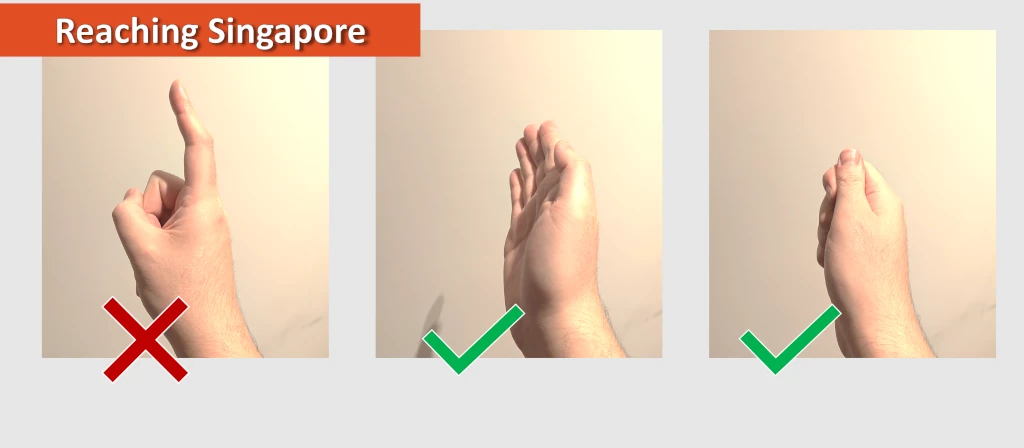
I made this mistake once though. I visited a local’s house, pointed (with one finger) at a statue, and said “what’s that”. This gesture of pointing at a Buddhist statue was very rude - this is the only time I’ve ever been called out for pointing with one finger, highly embarrassing!
Instead of pointing with one finger, use your whole hand to gesture in the direction you mean. Alternatively, you might see people make a fist and then use their thumb to point in a certain direction - this is OK too.
Also don’t motion for someone to approach you by curling one finger; this is a sign used for dogs and very rude for humans. If you want to motion for someone to come to you, move your fingers towards your palm as if sweeping them towards you.
DO clear your tray after eating at a hawker centre
Hawker centres in Singapore are a must-do for any visitor to the country. Some of the best food in the country is eaten outdoors, either in a hawker centre or coffee shop. Often that food is served to you on a plastic tray that you use to carry the food to your table to eat.
Clearing your tray when you finish eating by bringing it back to one of the tray return stands. There are tray return stands provided for non-halal and halal food (usually green for halal), return your tray to the correct stand when you’ve finished eating.
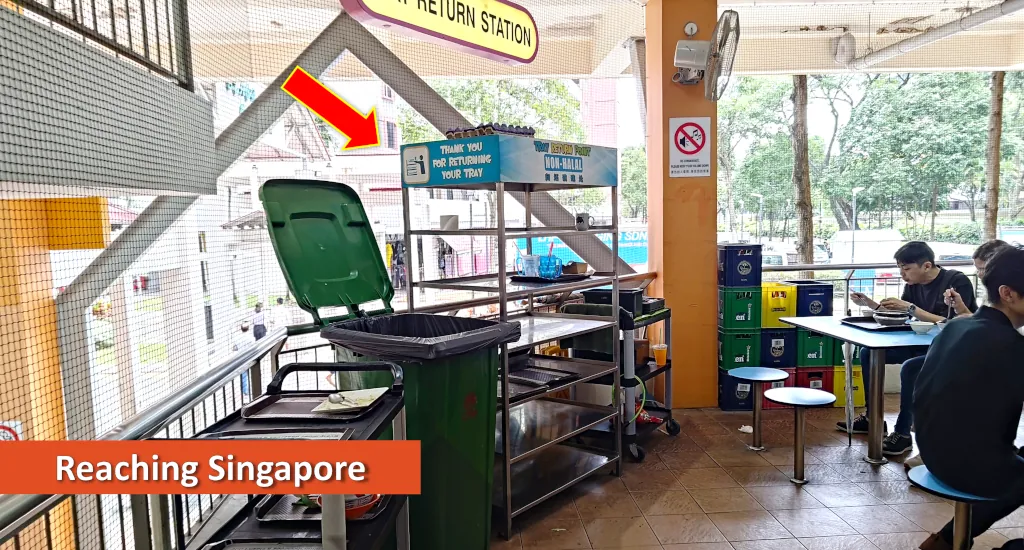
Singapore’s National Environment Agency is responsible for managing public hygiene at hawker centres. They established this rule in 2021. More detail on the rule can be found here. NEA also clarified you are not technically required to wipe the table after you eat, but it might be nice to do so if you left it very messy.
Despite the threat of a fine, authorities in Singapore prefer an education first approach. If you forget to return your tray, you will get a friendly reminder rather than a fine (unless you refuse or are argumentative).
DON’T hire a car
Singapore’s clean, spacious and calm streets (at least compared to its neighbours) might have you tempted to hire a car just like you would in Europe or North America.
Hiring a car in Singapore is expensive due to:
- High taxes on car ownership (for the hire car company)
- High fuel costs
- High car parking costs
- Lack of free car parking
- Electronic road pricing
Singapore actively tries to discourage people from driving private cars. It’s a small island where space is a luxury, so private car use is expensive to discourage driving.
Car hire typically costs S$160 per day for a small hatchback (e.g. Honda Fit). Given how expensive it is, even people with the budget for car hire tend to hire a driver or use taxis instead.
Thankfully public transport is great in Singapore. It is easy to catch a bus, train, or taxi to any part of the island, particularly in the modern age of ride-hailing and Google Maps.
Buses and trains are the cheapest, with each ride typically costing less than S$2! Taxis are slightly more expensive, typically costing between S$15 and S$40 depending on how far you travel and the time of day. Check out my guides here for more detail:
- My guide on how to catch the train in Singapore: reachingsingapore.com/singapore-catch-train-guide
- My guide on how to catch the bus in Singapore: reachingsingapore.com/singapore-catch-bus-guide
- My guide on how to catch a taxi in Singapore: reachingsingapore.com/singapore-catch-taxi-guide
DO spend time at the airport
Singapore’s Changi airport is often ranked as the world’s best (by Skytrax). This means that it is worth spending time in, either by getting to your flight early, or spending time here in transit.
While spending time in the airport, check out:
- A pool that you can access for S$30 (more detail here)
- A huge variety of local food
- Duty free shopping
- Free movies in a theatre
- A butterfly garden
- Indoor slide
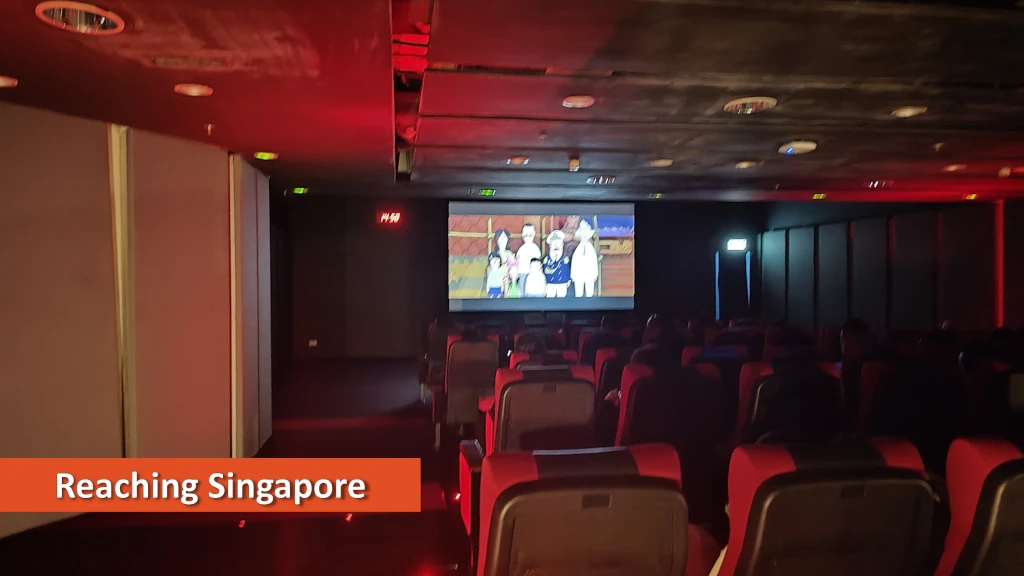
Jewel, home to the famous indoor waterfall, is also worth spending some time in. As well as marvelling at the waterfall, you can eat a variety of Singapore food, keep the kids busy with indoor slides and playgrounds, and pick up snacks and souvenirs for your journey home.
DON’T be afraid to walk
Singapore is a tropical country nearly on the equator - it does not experience seasons, it is hot and humid for most of the year. If I told you to walk around in Singapore, you might be put off by the climate - don’t be!
Walking around Singapore gives you a chance to experience the city at street level. You can see the people, the culture, hear the sounds, and explore anything that might look interesting.
Walking is also free. This gives you a saving of around S$1.10 compared to public transport, or S$10 compared to a taxi.
If your journey is only 1-2 stops on the MRT, you might even save time by walking. It takes a long time to travel underground to the MRT platforms, and then travel back up to the street again at the other end. If you’re only going a couple 1 or 2 stops on the MRT, then try walking instead.
That said, I understand the importance of air conditioning in Singapore. If you want to keep cool, the bus is a great alternative to walking.
DO catch the bus
Buses in Singapore are frequent, clean, cover most of the city, and air conditioned. This makes buses a great place for a quick escape from the heat and humidity of exploring Singapore on foot.
Most trips on the bus cost less than S$2. If you’re on travelling a few stops, they can be as cheap as S$1.09.
Buses also give you a street-level view of the city. You can watch as people go about their lives, and keep an eye out for anything interesting that you might want to explore.
My hint for tourists is to try to get a seat on the upper level of double decker buses. They give you a better view of the life of Singapore, and are much cheaper than the Big Bus tour.
If you need help figuring out how to catch the bus in Singapore, check out my complete guide here: reachingsingapore.com/singapore-catch-bus-guide.
DON’T eat or drink on public transport
Singaporeans generally do not eat or drink when they walk around. But this becomes a requirement when you hop on a bus or step into a train station.
Eating or drinking on trains and buses is not allowed in Singapore. Singapore is a very clean city, and in an effort to keep trains and buses clean, eating is forbidden.
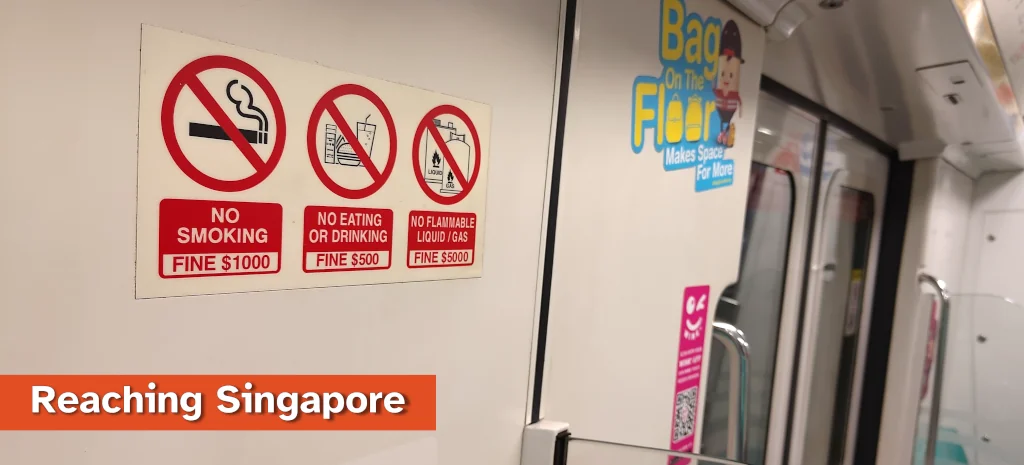
You are allowed to carry food or drink in containers. Many people in Singapore buy takeaway food from a restaurant and then carry it home using the MRT or bus. I used to do this when I lived near Old Airport Road hawker centre. Drinks often have sealed lids to help you do this.
Drinking water is also not a problem. The aim is to keep the vehicle clean for others to use. Even if you spill the water, it’s not a big deal.
Singaporean authorities take an education first approach. Even though there is a fine for eating or drinking on the MRT, you will be educated first and only fined if you keep doing it.
DO ride a bike
An increasingly popular way to get around Singapore is by bicycle. I encourage any visitors I host to get in on this trend as well.
Singapore has an extensive network of cycle paths, as well as bicycle hiring schemes. You can even hire a bike at Changi Airport - if you are transiting through Singapore and want to explore the city by bicycle, Changi Airport currently offers a free scheme for bike hire.
Renting a bike from a traditional store costs around S$15 per hour. Some of the popular locations are at the Esplanade Concert Hall (from here you can cycle around Marina Bay), and East Coast Park (which is connected all the way to Changi Airport).
Bicycle sharing schemes are also available and start at roughly S$1 per hour. These are very convenient as they have many locations across the city where you can hire and return, and you don’t have to return to the same location. I feel the bikes aren’t as good as the rental shops though.
DON’T tip
Tipping is not required in Singapore. Servers, restaurants, hotel staff, taxi drivers, and anyone else do not expect you to give them a tip.
A service charge is added to your bill instead. At restaurants where service charge is added, they’ll include a disclaimer at the bottom of the menu, or indicate that their price is “++” (meaning +tax +service charge).
Rounding up the fare in a taxi if paying by cash is something I usually recommend doing. Taxi drivers are happy to give you change, but I always find it a hassle to have lots of coins leftover after a trip. I usually recommend rounding up to the nearest dollar when paying by cash in a taxi.
I wrote a whole guide on not tipping in Singapore, check it out here: reachingsingapore.com/tipping-in-singapore.
DO carry cash
Singapore is nearly a cash-less society. For visitors to Singapore though, I still recommend carrying cash.
I like to carry S$50 to S$100 with me in cash when I travel around Singapore. Usually I try to keep this in a mix of S$10 and S$50 notes (not everyone likes giving change for S$50).
Hawker centres and taxis are the two places that visitors will need cash. For most other purchases in Singapore, there are cash-less options available, particularly credit card (Visa or Mastercard). Even the buses and trains accept Visa and Mastercard (despite the fees attached, I recommend visitors use credit card on public transport, check out my guide here for more detail).
Hawker centres generally do not accept credit card. They do accept QR code payments, however these are not available to most visitors to Singapore. Therefore I recommend visitors carry cash. (Lau Pa Sat is an exception to this, they accept credit card)
Budget roughly S$15 to S$30 per person for a hawker centre meal, or up to S$80 per person if you plan to order seafood.
Taxi rides are the other purchase I recommend visitors make in cash. This is because the taxi companies charge a massive 10% surcharge if paying by credit card. Budget roughly S$15 to S$30 for a taxi ride, slightly higher if you are coming in from Changi Airport.
Not all taxis reliably accept credit card either. I wrote a whole guide on the different payment methods that each taxi company supports, check it out here: reachingsingapore.com/taxi-payment-singapore.
DON’T litter
Singapore prides itself on being a clean city. Littering is of course banned.
Please use rubbish bins to dispose of litter. Rubbish bins can be found at bus stops, along popular streets, and in shopping malls (escalators, elevators, and toilets).
Singaporeans tend not to walk around eating, meaning they do not generate litter; they tend to dispose it around the shop it was purchased.
There are fines for littering, and it’s hard to claim ignorance (unlike the rules I mentioned above about eating on the MRT or not returning your tray at a hawker centre). I haven’t heard of tourists being fined for littering in a few years, but it can happen.
DO dress for the weather
Managing heat, even when walking around, is something that Singaporeans are accustomed to having lived here for so long.
Dressing for the weather means choosing something appropriately cooling to wear conscious of the high heat and humidity. I was visiting Singapore once with a colleague from London to give an important presentation to a client; my colleague arrived in a 3-piece woollen suit, as he would dress when attending an important meeting in London. Our local colleagues counselled us that even though we would be in an air-conditioned office building, such wearing such a thick suit might still cause exhaustion.
Some tips on dressing for the weather in Singapore:
- Choose lightweight natural fabrics such as linen or bamboo, these are more breathable
- Wear lighter colours that help to reflect sunlight
- Dress comfortably and don’t wear too many layers
DON’T be afraid to dress up
Dressing for the weather doesn’t mean dressing like a slob though.
While many places in Singapore do not object to men wearing flip-flops, sandals, or other similarly “dressed down” attire, there are still many places where you will feel out of place for doing so.
For men, I recently found this video on YouTube that was really helpful in figuring out how to dress up in a hot climate: https://www.youtube.com/watch?v=2Y9mkAPRatE
Some places I like to dress a little nicer when I’m in Singapore:
- Bars and restaurants that have air conditioning
- Shopping at ION Orchard, Tangs, and Takashimaya
- Anywhere else I want the respect that dressing nice accords
DO join a queue
Singaporeans love to queue, at least that’s the way it looks when you see the locals naturally form a line while waiting for something.
Places you might have to queue include food stalls, train tickets, ATMs, and even escalators. Oddly enough, Singaporeans don’t tend to queue for buses, this is probably due to most stops being served by multiple routes.
Having to queue for a food stall is a hint that the food there is good. If a stall is popular with Singaporeans, chances are there’s a good authentic dish on the menu (do ask your fellow queue-ers what the dish is though, as it might not be clear from the menu).
DON’T block the escalators
Speaking of escalators, Singapore maintains a good order of stand on the left and walk on the right for escalators.
Please stand to the left if you are not walking up or down an escalator.
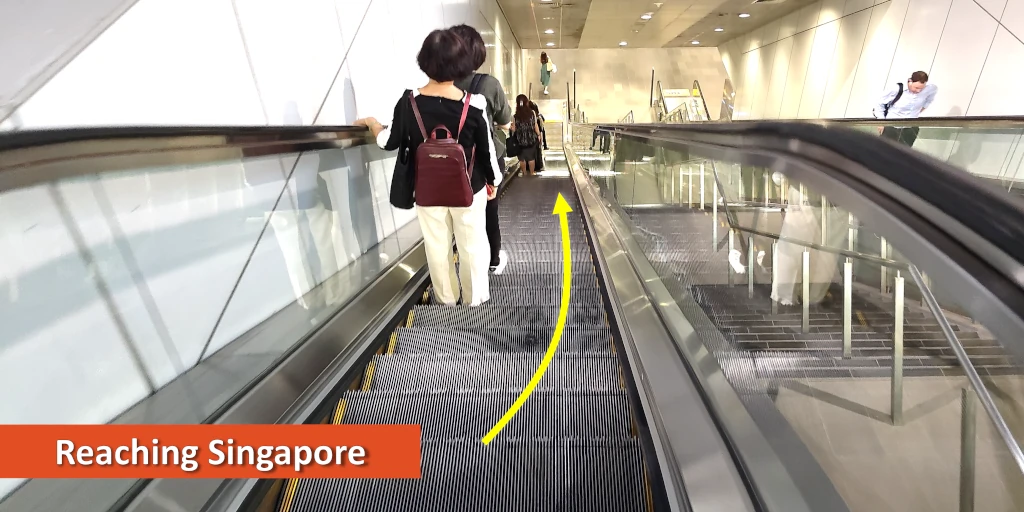
MRT stations, and the shopping malls leading to them, are usually where this rule is most important. People will be in a rush to catch their train and it’s polite to leave space for them to walk by.
Singaporeans tend respect this rule, even when it’s crowded.
Some escalators can be very long (e.g. Bencoolen MRT), take care if you’re walking up or down these escalators.
DO treat elders with respect
Like many countries in Asia, elders are treated with the utmost respect.
For tourists visiting Singapore, this usually means:
- Avoid “talking down” to people significantly older than you
- Give up your seat on public transport to the elderly
- Use of “aunty” and “uncle” when referring to someone older than you
I also find Asians tend to use relationship names when referring to people in conversation. Calling someone “brother” or “sister” can be used for same age, and “aunty” or “uncle” when the person is older - this is instead of using the person’s name (no need to use it as a prefix).
Interestingly, giving up your seat on public transport for a child is also really common in Singapore. I haven’t figured out the reasoning behind this yet, but I imagine it relates to the ‘village’ caring for the young.
DON’T start a fight
Breaking the law may sound like an obvious thing to avoid - and Singapore has a lot of laws that are often highlighted to visitors (drugs and chewing gum come to mind) - but this is one that I feel it’s worth reminding visitors of (my home country is Australia, where fights can occur).
Do not start a fight in Singapore. Do not get into a fight in Singapore.
You will lose. Either directly when the other person’s gang of friends and family come to help take care of you (unlikely these days) or when you are arrested by the police.
Singapore courts may seem to take a very harsh view on what is considered a minor crime in many western countries - and anything associated with a fight will likely attract a significant punishment.
While not every incident makes the news, there have been enough for respected local law organsation Singapore Legal Advice to write a full guide on what happens when you’re arrested and charged in Singapore. Check it out here.
DO bring an umbrella
Singapore’s weather is characterised as “hot and wet”. This means an umbrella is the perfect tool to carry around to deal with anything Singapore throws at you.
When it’s hot, an umbrella can help provide you shade from the sun and keep you that little bit cooler.
When it’s wet, the umbrella comes in handy to keep you dry (though in a tropical Singapore downpour, I often find it’s only my top half I can keep dry with an umbrella).
Singapore weather is generally predictable following these patterns:
| December to early-March (we often joke that this pattern ends with Chinese New Year) | Rain in the afternoon and evening, can rain all day, and is often windy |
| Late-March to May | Afternoon thunderstorms |
| June to September | Short showers or thunderstorms in the afternoon |
| October to November | Afternoon thunderstorms, often with more rain |
The Meteorological Service Singapore provides a guide on what sort of weather to expect for each of the times of year, including the rainfall. Check out their guide here.
DON’T comment on local politics
Singapore has a unique political situation forming as what I perceive to be a blend of its colonial past and its neighbours of Malaysia and Indonesia. This means it resembles a few different systems, but is also uniquely Singaporean at the same time. Singaporeans also adore and are proud of the founder of modern Singapore, Lee Kuan Yew.
I find locals simultaneously proud of their political situation, yet also full of complaints about it. Because of this, I recommend visitors to Singapore not share any opinion about Singapore politics past or present. Criticising Singapore laws falls under my recommendation here as well.
You may inadvertently offend someone, or even start a fight, by voicing your opinion in support or in opposition of any political issue. Best not to discuss politics (or religion for that matter) at all.
DO carry a packet of tissues with you
Few things are as versatile and as easy to carry around with you in Singapore as a packet of tissues. Locals will often carry around a packet because they are useful in so many situations.
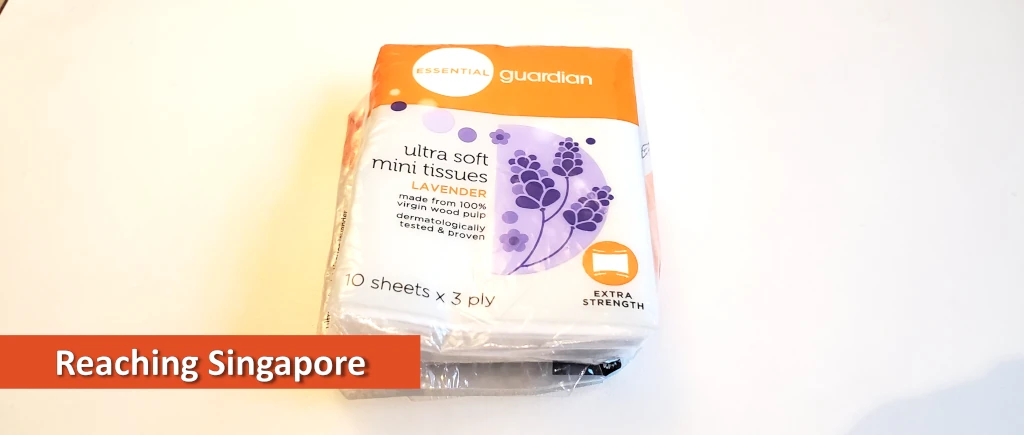
Packet tissues are great for:
- Reserving a table at a hawker centre or coffee shop (locals call this ‘chope’, meaning to leave something on a table to reserve it)
- Cleaning a dirty table before you use it
- Cleaning your fingers after eating or doing something dirty
- Wiping the sweat off your forehead and neck
You can buy packet tissues from a pharmacy, a drink stall at a hawker centre, or tissue sellers who will come up and offer them to you while you are eating or by the side of the road. Tissues typically cost between 50 cents and S$2 per packet (tissue sellers are generally more expensive as it’s a form of welfare).
DO try local coffee
Singaporeans love to drink kopi - that’s the word used for the locally brewed coffee. It has a unique flavour, somewhat similar to Vietnam, but less bitter. It is also cheap.
Local kopi costs less than S$3, and can often be found for less than S$2 at local hawker stalls and aptly named coffee shops.
There is also an art to ordering kopi. I like to drink mine as “kopi C kosong ice”, this means coffee with evaporated milk and no sugar. The standard “kopi” uses condensed milk that I find too sweet.
Some other popular orders include:
- Kopi siu dai - hot coffee made with condensed milk but less sweet
- Kopi O - hot coffee served black
- Yuanyang - a mix of tea and coffee

